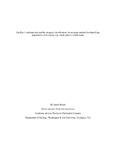GeoEye-1 Multispectral Satellite Imagery Classification: An Accurate Method for Identifying Populations of Acropora spp. Corals Prior to a Field Study (thesis)

View/
Author
Busch, James F.
Subject
Washington and Lee University -- Honors in Geology
Corals -- Ecology
Belize -- Ambergris Cay
Coral reef conservation
Coral reef biology
Acropora
Research
Remote-sensing images
Metadata
Show full item recordDescription
Thesis; [FULL-TEXT FREELY AVAILABLE ONLINE] James F. Busch is a member of the Class of 2015 of Washington and Lee University. In recent decades Caribbean coral reefs have experienced drastic decline in live coral cover. Some of the main framework-building coral species Acropora cervicornis, Acropora palmata, and the new hybrid species Acropora prolifera have suffered the greatest collapse. Coral Gardens, Belize is one of the few remaining refugia for abundant, healthy populations of Acropora species coral. GeoEye-1 multispectral satellite imagery of a 25 km2 area near Ambergris Caye was analyzed to identify live Acropora spp. cover in the greater Coral Gardens region. A supervised classification was used to predict areas which contained live Acropora spp. coral and separate them from other benthic cover such as mixed sand, seagrass, macroalgae, and mixed massive coral species. In the field, classification accuracy was tested by sending snorkelers to the region of suspected live Acropora spp. coral to document bottom composition, and as appropriate, species of coral present, approximate live coral cover, depth, orientation of live coral, species of corals present, and height of the tallest live coral. Locations were recorded using a differential GPS unit to map previously undocumented populations of Acropora spp. corals. Of the ten predicted areas, eight were dominated by substantial populations of healthy Acropora spp. coral. Reference points and newly mapped regions from the field data were used in conjunction with a refined classification technique to improve the accuracy of locating Acropora spp. corals within the image. The final classified image successfully separated Acropora spp. corals from other benthic cover with an overall accuracy of 89.9%. This technique can be used as a relatively quick, inexpensive species-specific tool for identifying, monitorying, and conserving populations of Acropora spp. corals for the future. James Busch